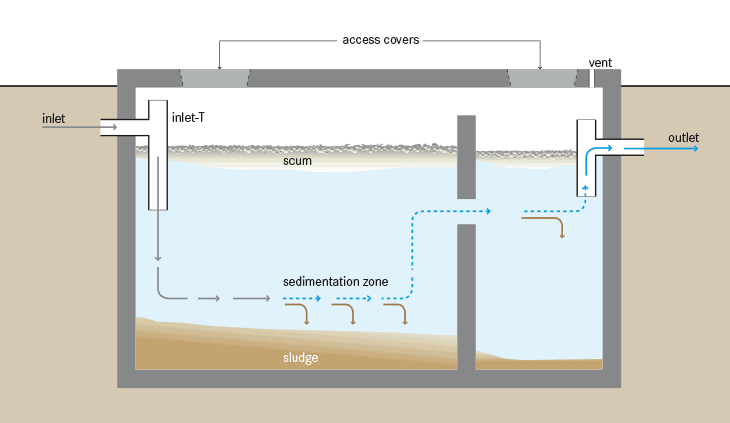How To Know If Your House Has A Septic Tank?
How do you know if the property you are currently living in or the one you are about to buy has a septic tank? In this article, we will discuss how to know if your property is served by a public sewer or septic system, how to locate a septic tank, and how to find one if it is an old property, and a lot more.
So, to answer the question does my house have a septic tank?– Your home will either be serviced by a public sewer system or property-specific waste management system, like a septic system. If your home doesn’t pay public sewer fees and taxes, this is the best indicator your home is most likely serviced by a septic system.
That’s not all, there are many ways to find a septic tank in a property. So, if you want to know if your house has a septic tank or it is connected to a sewer, keep reading

How Do You Know If Your House Has a Septic System?
There are several ways of telling if your house has a septic system. Check your sewer bill. When there is a septic system that manages wastewater, you will find $0 charges as a sewer or water bill from your utility company.
The location of your home also helps in knowing if your property has a septic system or there is a public sewer. People in a highly rural area will very likely have a septic system. In case you are not sure, you can also ask your neighbors what they have. If they have septic, your property will most likely also have one.
You can also search for visual signs in and around your property, which indicate the location of the septic tank. If you find a small hill or a mound that doesn’t seem natural, it may be a sign of the presence of a septic system. Such mounds are formed when the installation of the septic tank takes place.
One of the best ways to check is to see the property records, especially when you are buying a new property. The blueprints of your house, or the building permit or the property records will have the information related to the presence or absence of a septic tank.
Call you local city public works and zoning and they can tell you what you house is zoned for.
Ways to Find if My House Currently Has a Septic System or sewer?
There are 4 easy steps to find if your current house is connected to a sewer or there is a septic system. Check these steps:
Step 1 – Check your premises for any kind of unnatural mound of earth or hill. This can be cylindrical in shape or rectangular. This mound acts as a cover of the drain field. If you can see this mound, it may be the septic system.
Step 2 – Where are you located? Sewer systems are expensive and to have them there should be enough homes. This assures maintenance of the system. If you stay in a busy neighborhood or a subdivision, you will most likely have a public sewer system. If you are in an area where there are just a handful of properties, there will most likely be a septic system.
Step 3 – Have a look at the water or sewer bills. Are you being charged for community sewer systems or fees? If yes, then there is no septic system and your home is connected to sewer lines.
Step 4 – Find the property records of your home. You can also check the building permits. You will get all the details of the system there.
How to Find a Septic Tank in Any Old Property
Finding a septic tank in an old property can be challenging, especially when the existing owner or even the prior owner, does not have an idea about the location of the tank. At times the owner is confused or cannot recall the location of the tank.
In such situations, a probe or excavation can help in finding the location of the tank. A metal detector helps in locating any buried drain or different components of the septic system. If the owner can provide an idea about where the tanks can be located, excavation is carried out.
If there are similar old properties in the neighborhood, then it is easy to spot because the tank will probably be in the same area as your neighbor’s. If any neighbor has found the location, it can help as well as the septic tank can be in the same spot in this property as well.
Are Septic Tanks Located Under a House or Inside a House Safe?
If a septic tank is well constructed and is sealed, there is no danger or any threat related to contamination. Many homes have them in or under their homes. This is especially when the space is limited.
Finding the Lid of a Septic Tank in a Property
What happens if you cannot find the tank lid on the ground level? You know your septic tank is full and you have to empty it. You do not have any idea about the location of the septic tank, so how do you manage to get the lid?
Check some ways to find the lid of the septic tank:
- Check the Map – Counties have permit records related to the installation of septic tanks. Such a record has a diagram that depicts the septic tank location. You can get the location there.
- Home Inspection Papers – Check your home inspection paper. Whenever a property is bought or sold, there is a home inspection. A diagram of the septic system & its location is included in home inspection records.
- Look for Signs – Check for probable signs on the surface. Are there any high or low spots in the yard? Does the grass color look different or growing fast in any area? You can check such spots.
- Search for Marks – If professionals have buried the lid, they will mark this spot for future reference. Look for any marks in the form of a colored brick or a stone which seems to be unusual. It might just mark the lid.
- Find the lid – These septic tanks are usually rectangular in shape. They are 5 feet by 8 feet. You can probe around the tank and find its edges. You will again mark its perimeter. Any two-compartment tank that is installed after 1975, will have two lids.
These lids can be made from polyethylene or fiberglass. If you excavate this area a bit, you will definitely be able to find one.
These were some of the DIY ways to find the septic tank of your home. If needed, you can use tools like a magnetic locator to find the septic tank components. It will make your work easier.
What Are Some of The Places Where You Will Not Find The Septic Tank?
When you are looking for clues that will help you to find a septic tank, there are a few areas, where you should not spend time searching. This is because the septic tank is usually not found in these places.
What are the areas where the septic tank will not be located?
- It will not be right next to a well, in case there is a well on your premises.
- The septic tank will never be very close to your home
- It will not be close to the boundary walls or the swimming pool.
- It will not be near the trees.
- It will not be in any area where there are heavy plantings.
- It will not be right under the drive.
- You will not find it below any paved surface.
- It will not be under any deck or patio
- You will not find it under any paved structure.
To conclude, we can say that you can easily find if your property has a septic tank, by following any of the above steps. In case you still need help, you can get in touch with professionals who can also assist you in finding the septic tank in your home.
Sources:
https://www.mrrooter.com/greater-syracuse/about-us/blog/2015/march/how-to-find-your-septic-tank/
https://inspectapedia.com/septic/Septic_Tank_Locating_Tools.php










